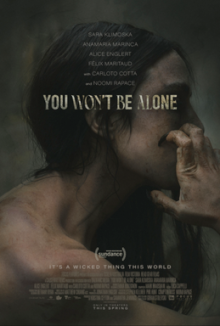I expected this Macedonian language film about witches in the 19th century to be squarely in the horror genre but as my wife notes, it really isn’t horror at all. It’s actually a sort of fantasy drama with very strong humanistic themes. The core premise is sound and fits the setting well. Unfortunately it is let down by lackluster production values including a weak eye for cinematography and cheap visual effects. It’s solid work but it’s perhaps more ambitious than what director Goran Stolevski could actually pull off.
Rather than give her newborn baby to a badly burned witch, a mother hides her in a cave. The girl Nevena grows up without the ability to speak and without any knowledge of the outside world. When she is sixteen years old, the witch Maria enters the cave anyway in the form of an eagle, kills her mother and transforms Nevena into a witch herself. Maria tries to raise Nevena as her own daughter and the girl learns how to take on the forms of the animals and people she kills. Maria insists that associating with normal people will only end in tragedy but Nevena keeps being drawn to them. In one village, Nevena accidentally kills an adult woman who has just given birth and takes on her form. The other villagers think that she has gone mad from the shock and teaches her how to live as a human all over again including how to eat properly, wear clothes and perform chores. When she accidentally kills people with her talons, she takes on other forms as well including that of an adult man and in this way learns all of the different aspects of human life. Throughout Nevena’s many lives, Maria watches her and occasionally appears to warn her against becoming close to humans.
Once you get past the whole horribly scarred witch with talons that let her kill just about anything aspect, it’s evident that this is not a film that is meant to scare the audience at all. It’s really about how even monsters can learn compassion and love and to live as human beings. Nevena’s ability to take on different forms even allows her to learn about life from more perspectives than any ordinary human. She experiences how men and women are treated differently by society, learns to appreciate the simple sensory pleasures of eating food, breathing in the open air and once she overcomes the pain and unfamiliarity of it, even the joys of sex. Every once in a while she messes up and kills people but her disguised form seems to be perfect so she always gets away with it and just restarts again. Maria represents the outsider who is driven by envy even as she stands apart and disparages what she sees. It’s a positive, life affirming message despite the gore and the violence.
The thing is, I’m almost positive that Stolevski is consciously channeling the style of Terence Malick here. It’s not a bad thing to copy the work of the grandmasters of course but Stolevski seems to be trying to achieve similar results with a fraction of the time and resources available. You can see that his camera work is reaching towards the same kind of sublimity but it never makes it all the way and sometimes ends up just looking boring. The makeup to have Maria look horribly burned is awful and makes the film feel unserious. They actually include some detail into the limitations of the witch’s spells and how the ritual to make another witch works only once. You can feel how Stoveski means it to be meaningful and weighty but emotionally it falls flat. Similarly, Maria’s backstory is so generic that there wasn’t even any need to actually lay it out. Simply dropping some imagery and hints would have been enough. Malick understood that to touch the sublime it’s necessary to leave some room for mystery. I don’t believe that Stoveski is mature enough to get the balance right.
The ambition shown here is laudable and it does feel right to root this in the peasantry and superstitions of 19th century Macedonia. Yet the execution is lacking, making this a solidly respectable film but in my opinion, it’s still some way short of being truly good.
